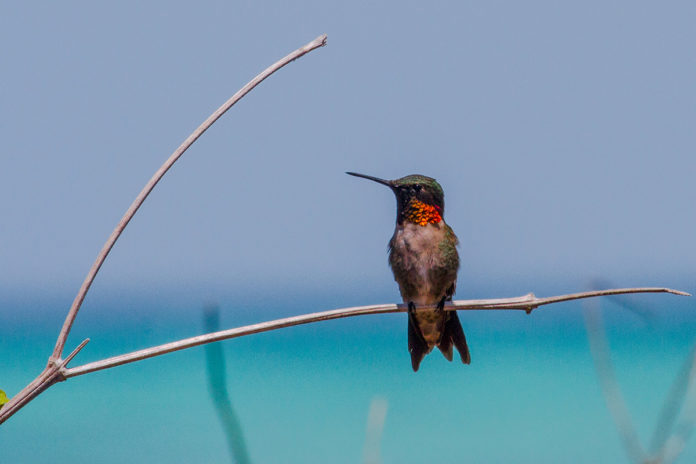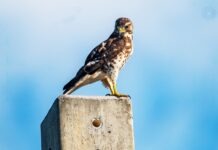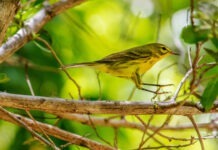What are the best ways to attract hummingbirds in the Keys? — Ethel’s Friend
There’s only ever been one hummingbird species recorded in the Keys – the ruby-throated hummingbird. They are the one species that breeds regularly east of the Mississippi, but they don’t breed here. They winter here. You can see them any time from September to early May. (The ones here now will be heading north in the coming weeks.)
Oddly, though, they show absolutely no interest in feeders while they’re here. I’ve made five or six good-faith attempts to attract them to the yard with feeders, and each time I’ve grown sadder and sadder as the nectar went rancid. The only time I’ve known them to go to feeders was in the immediate aftermath of Hurricane Wilma in 2005, when all the trees, bushes and flowers were stripped bare.
Hang up a hummingbird feeder nearly anywhere else, and ruby-throats will zip through your yard all day long. But here in the Keys they seem to turn their bills up at them.
I used to think that maybe, because we have so much lush foliage and so many flowers, they were just skipping the human-made nectar in favor of less processed nectar. But then I traveled around the Caribbean and South America and saw all sorts of hummingbirds gulping nectar at all sorts of feeders. So the organic purity theory doesn’t hold (sugar) water.
But don’t give up hope. Ruby-throated hummingbirds seem to love red flowers while they’re here. If you hang around a while near a Hong Kong orchid tree in a neighborhood, I’m pretty sure a hummer will show up. If a tree is too big a commitment, consider something smaller like firebush. There is also some solid advice about such things in Kirsten Hines and James Kushlan’s book, “Attracting Birds to South Florida Gardens.”
If you plant something this summer, maybe it will grab their attention next fall.
Why do birds suddenly appear? — Mr. Big Year
Just like me, they long to be. Also, it may be that long trail of breadcrumbs that falls out of your pant leg wherever you go.
Which birds are monogamous? — Jane, the Golden Retriever Lady
I don’t want to get all Bill Clinton about it, but it depends on how you define monogamous. Monogamy in the bird world is not the same as monogamy in the human world. Bird monogamy is closer to human serial monogamy. Think of the song “Summer Nights” from “Grease.” Though instead of “Summer fling / don’t mean a thing” it’s “Summer fling / means our genetic material is carried on to breed future generations and to share the workload of raising young in the immediate future…” (Is this the wrong time to point out that the line from that song, “Tell me more, tell me more / did she put up a fight?” has not aged well?) But basically, there is a lot of monogamy in the bird world, just of the serial sort.
That being said, some bird species do, in fact, mate for life. Swans are famous for it, and most species of swans do breed for life. Also bald eagles, black vultures, Atlantic puffins and scarlet macaws. But keep in mind that after, say, a failed breeding season, a lot of bird couples will break up and seek new partners. And there is a lot of extra pair copulation, or what the Eagles (the band, not the birds) refer to as “headin’ for the cheatin’ side of town.”
Also, lifetime monogamous species are usually only together in their breeding territories during the breeding season. The rest of the year they go their separate ways. And if a mate doesn’t return in time come spring, they will often tip their cap at another bird pretty quickly.
How far north do the Cuban finches migrate? — Anonymous at NAS
Knock it off, Danette.
Have you ever seen baby hummingbirds? I have a strong memory of once seeing them, like a cluster of beaky bumblebees, when swimming in a pond in rural Northern California. However, I had just emerged from a sweat lodge, and was wholly tripping, and never spotted them again despite living lots of places since then with regular hummingbird sightings. — (Happy) Valley Girl
I’ve never seen a baby hummingbird in real life, but I’ve seen several pictures of them.
Baby birds can basically be divided into two categories: precocial and altricial. Precocial chicks can walk or swim almost as soon as they hatch. They also tend to have a thick layer of downy feathers already. They are born toddlers. Precocial species tend to build their nests on the ground in open spaces, making them vulnerable to predators, so the ability to move and find shelter is crucial to the chicks’ survival.
Altricial species generally hatch their young in what we humans tend to think of as traditional nests: cups of sticks hidden away in the tree canopy. The chicks are born blind, featherless and helpless. Unless you’re good at climbing trees or figuring out where their nests are, or unless the bird parents decide to forgo stealth and build their nest in a manmade structure or a more exposed tree, you generally won’t see them until they are full grown and ready to fly. Other than plumage patterns, the young look much like adults. (In a lot of cases, especially with passerines, juveniles look very similar to females.)
There is a bit of a spectrum among the world’s 10,000 bird species between precocial and altricial, but all hummingbird species fall heavily into the altricial camp. They are born tiny and nearly bald with translucent bluish to pinkish skin and stubby, inelegant bills. They don’t look like the gleaming metallic micro-gods that they are until they are fully grown. So, sorry, it’s unlikely you saw a cluster of baby hummingbirds.
TL;DR: You were tripping balls.






















